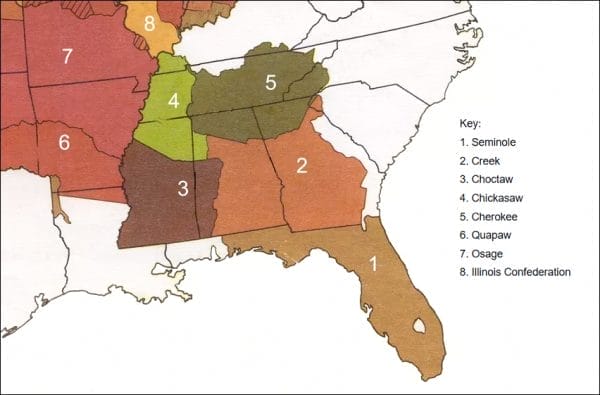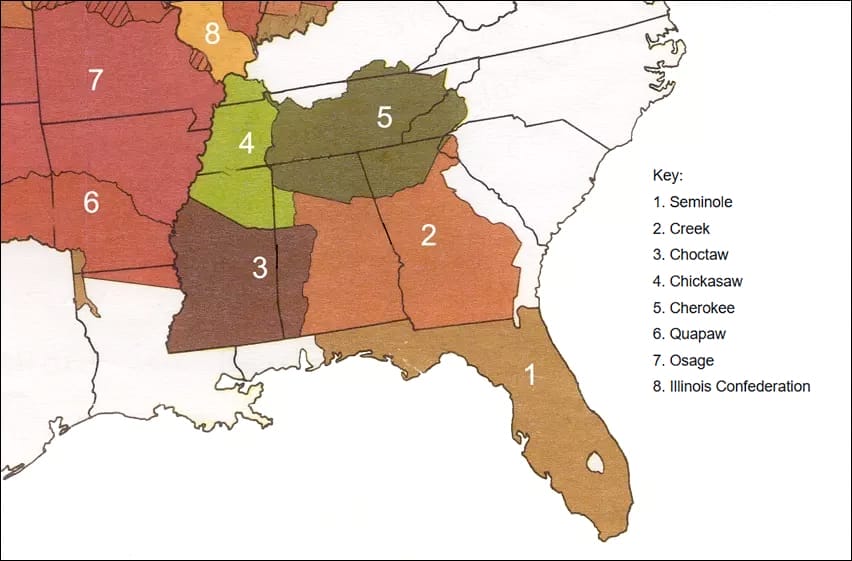Creeks in Alabama
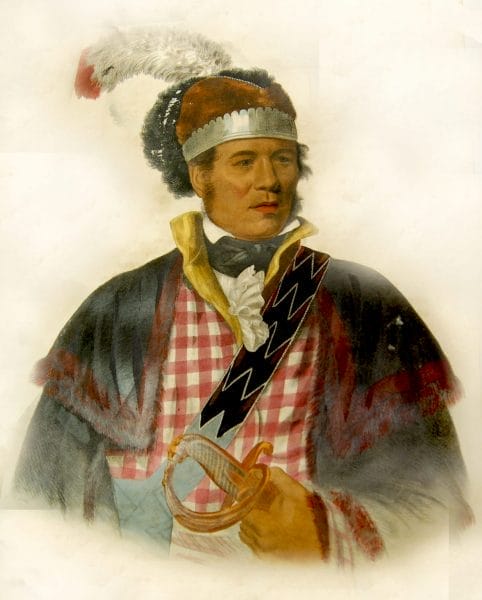 William McIntosh
A confederacy of a number of cultural groups, the Creeks, now known as the Muscogee (Creek) Nation, played a pivotal role in the early colonial and Revolutionary-era history of North America. In 1775, author and trader James Adair described the Creek Indians as “more powerful than any nation” in the American South. Despite the fact that they were able political and economic partners of the colonial and early U.S. government, the Creeks suffered the same fate as their fellow southeastern tribes, and many of them were forced from their lands in the 1830s. Creek culture is kept alive in Alabama among the Poarch Band of Creek Indians, based in Escambia County.
William McIntosh
A confederacy of a number of cultural groups, the Creeks, now known as the Muscogee (Creek) Nation, played a pivotal role in the early colonial and Revolutionary-era history of North America. In 1775, author and trader James Adair described the Creek Indians as “more powerful than any nation” in the American South. Despite the fact that they were able political and economic partners of the colonial and early U.S. government, the Creeks suffered the same fate as their fellow southeastern tribes, and many of them were forced from their lands in the 1830s. Creek culture is kept alive in Alabama among the Poarch Band of Creek Indians, based in Escambia County.
The Creek Indians, along with other southeastern tribes such as the Choctaws and Cherokees, are descended from the peoples of the Mississippian period (ca. AD 800-1500), known for its giant earthen mounds and complex, hierarchical social structure. In the sixteenth century, the arrival of Europeans brought epidemics and widespread warfare and violence to the Southeast, resulting in the scattering of the region’s indigenous peoples. Beginning in the seventeenth century, these diverse populations joined together and established settlements along the central Chattahoochee River, the lower Tallapoosa River, and the central Coosa River in what is now east-central Alabama. For the next two centuries, these areas served as the heart of what came to be called Creek country, and these new towns (talwa in the Muskogean language of the Creeks)—devoid of the earthen platform mounds that typified Mississippian villages—became the centers of Creek political and ceremonial life and defined the political identity of each Creek individual.
As a political unit, the Creek Nation grew gradually during the century and a half prior to their removal from Alabama in the 1830s. From as few as perhaps 9,000 persons in the 1680s, the Creek population increased to about 20,000 by the time of the American Revolution and exceeded 21,000 at the time of removal. Muskogee- and Hitchiti-speaking peoples from the main Creek towns made up the major portion of the population. But the Creek nation was multiethnic and included Indian peoples from Spanish missions in Georgia and Florida as well as Yuchi, Shawnee, Chickasaw, and Natchez refugees, who fled to Creek country to escape intertribal warfare and conflicts with French and Spanish colonists.
Creek Identity
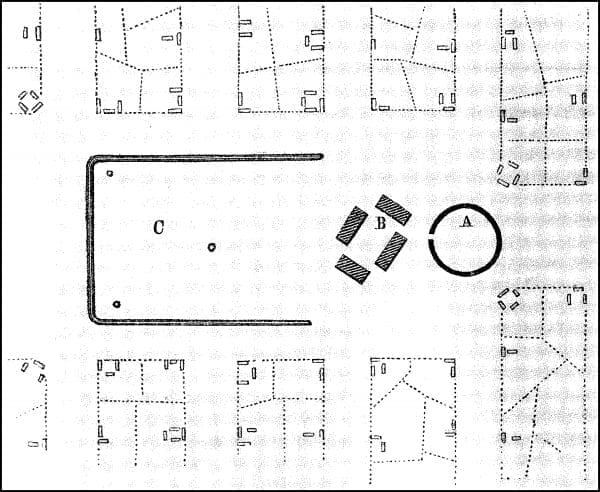 Engraving of Creek Town Layout
Though the numbers fluctuated over time, the Creek nation was generally comprised of between 30 and 60 towns (talwa), with each group primarily identifying itself with the major town in its region. Thus national unity was often hard to come by in Creek country, given the independence of each town and the multiethnic composition of the nation. In fact, the name “Creek” was a term English traders first used as a convenient way to label the people of various Creek towns. The Creeks themselves tended to view their nation as a confederacy consisting of three distinct provincial groups: the Ochese or Coweta of the Chattahoochee River basin, the Tallapoosa of the lower Tallapoosa River, and the Abeika of the upper Tallapoosa and Coosa rivers. The British and Americans, however, tended to refer to the first group as the “Lower Creeks” and the latter two groups together as the “Upper Creeks.”
Engraving of Creek Town Layout
Though the numbers fluctuated over time, the Creek nation was generally comprised of between 30 and 60 towns (talwa), with each group primarily identifying itself with the major town in its region. Thus national unity was often hard to come by in Creek country, given the independence of each town and the multiethnic composition of the nation. In fact, the name “Creek” was a term English traders first used as a convenient way to label the people of various Creek towns. The Creeks themselves tended to view their nation as a confederacy consisting of three distinct provincial groups: the Ochese or Coweta of the Chattahoochee River basin, the Tallapoosa of the lower Tallapoosa River, and the Abeika of the upper Tallapoosa and Coosa rivers. The British and Americans, however, tended to refer to the first group as the “Lower Creeks” and the latter two groups together as the “Upper Creeks.”
The Creek people applied kinship terminology to designate each town’s relationship to others, based upon the perceived age of a town or size of its population. The Creeks regarded older towns, for instance, as “grandmother” towns, whereas newer towns often carried the designation of “daughter” or “grandchild” towns. The Creeks also divided their nation into “war” and “peace” towns, represented by the colors red for war and white for peace. In diplomacy and warfare, the groups represented by each town could act as independent units, as each was comprised of a dual hierarchy of civil and military offices. The Creek peoples recognized some groups and their towns as particularly influential in national affairs. Creek oral tradition describes the Coweta, Cusseta, Tuckabatchee, and Abeika as the four “foundation” groups of the nation. The Coweta and Cusseta, according to Creek histories, were closely related and exercised great influence among the Creeks of the Chattahoochee River. Leaders of towns among the Tuckabatchee, Okchai, Okfuskee, Talassee, and Abeika tended to dominate political affairs among the Creeks of east-central Alabama.
The Creeks are culturally and linguistically related to other southeastern Indian tribes, particularly Muskogean-speaking peoples such as the Choctaw and Chickasaw. Like their Indian neighbors, the Creeks were horticulturalists who grew corn and several other crops, supplemented by seasonal hunting for white-tailed deer and other game animals. The Creek busk ceremony, or poskita (in Muskogee, “to fast”), shares many aspects of the Green Corn Ceremony practiced throughout the Southeast. It was the centerpiece of the yearly cycle of rituals that occurred in mid-summer and generally involved four to eight days of fasting, dancing, and (at the end of the ceremony) feasting. During poskita ceremonies, the elders reminded the young of their responsibilities to the tribe. The chiefs pardoned people who committed offenses against other members of the tribe. Quite often it was the time when war and civil leaders received new offices and new names to reflect their change in status. The emphasis of the poskita ritual was group harmony.
Contact with Colonists
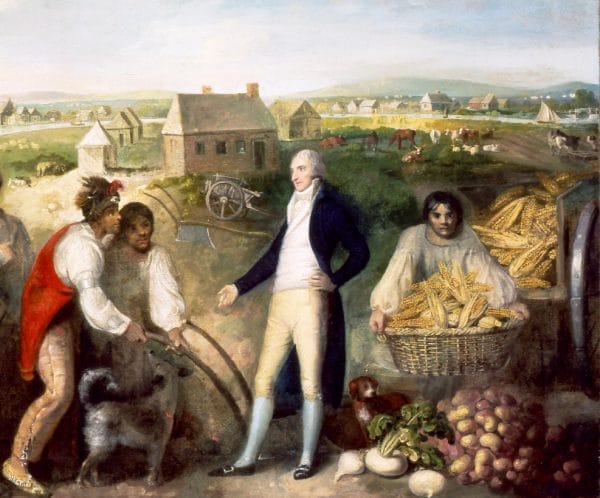 Benjamin Hawkins and the Creek Indians
Creek contact with European colonists was intermittent at first and largely occurred through trade and diplomacy with Spanish Florida. Their involvement with colonial powers became more pronounced by the middle of the 1680s, when traders from South Carolina began venturing directly to Creek villages. A brisk trade ensued, and colonial traders exchanged cloth, guns, and steel tools for deerskins and, notably, Indian slaves taken in warfare from other tribes. In 1690, in order to facilitate trade with the South Carolinians, the Chattahoochee towns and allies from among the Tallapoosas and elsewhere moved and relocated their towns on the Ocmulgee and Oconee Rivers in central Georgia. At one such town—Ocmulgee—English traders built a permanent trading post that has been the subject of archaeological investigation. Its remains are contained within the Ocmulgee National Monument in Macon, Georgia.
Benjamin Hawkins and the Creek Indians
Creek contact with European colonists was intermittent at first and largely occurred through trade and diplomacy with Spanish Florida. Their involvement with colonial powers became more pronounced by the middle of the 1680s, when traders from South Carolina began venturing directly to Creek villages. A brisk trade ensued, and colonial traders exchanged cloth, guns, and steel tools for deerskins and, notably, Indian slaves taken in warfare from other tribes. In 1690, in order to facilitate trade with the South Carolinians, the Chattahoochee towns and allies from among the Tallapoosas and elsewhere moved and relocated their towns on the Ocmulgee and Oconee Rivers in central Georgia. At one such town—Ocmulgee—English traders built a permanent trading post that has been the subject of archaeological investigation. Its remains are contained within the Ocmulgee National Monument in Macon, Georgia.
The years that the Creeks spent in central Georgia (ca. 1690–1715) proved to be pivotal ones. Because of their ties to South Carolina traders, they became deeply immersed in the trade in deerskins and Indian slaves, as well as the conflicts with Britain’s imperial rivals, Spain and France. Creek war parties played an important role in destroying Spanish Indian missions along the Georgia coast and in the Florida mission provinces among the Timucuas and Apalachees, whom the Creeks often enslaved or sold as slaves to the South Carolinians. Having brought Spanish Florida to near ruin by 1706, the Creeks began seeking slaves in such far-off places as the Florida Keys and the Choctaw settlements of Mississippi. English officials compelled Creek war parties to assist in their wars against Spanish and French outposts (Queen Anne’s War, 1702–13) and against the rebellious Tuscarora tribe of North Carolina (Tuscarora War, 1711–12). By 1715, the Creeks and other Indian nations found that their formerly beneficial relationship with South Carolina had ensnared them in a cycle of debt and warfare that compromised their economic well-being, if not their cultural and territorial integrity.
Strategy for Wartime
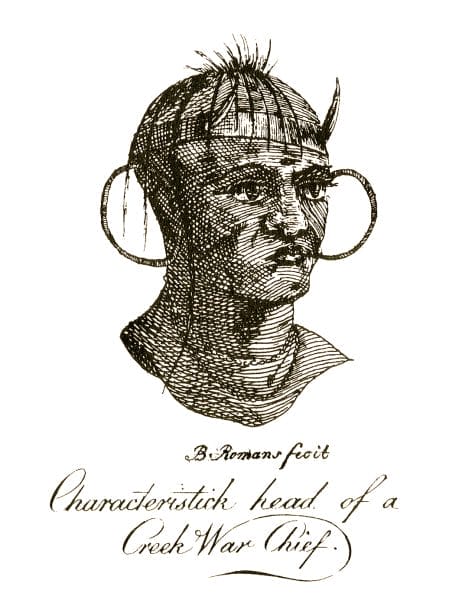 Creek Warrior Sketch
The Yamasee War of 1715 ushered in a new diplomatic era in Creek history. On Good Friday (April 15, 1715), the Yamasees, Creeks, and other allies launched a war against South Carolina, while at the same time seeking new alliances with the Spanish and French. By the end of the war the Creeks had settled upon a strategy by which they pledged to remain neutral in times of war between the three European powers. Established at a meeting in the Lower Creek town of Coweta in March 1718, and devised by that town’s chief, known to the English as the “Emperor” Brim, the policy of neutrality increased their political leverage by enabling them to defend their ancestral territory by “playing off” one European power against another. Creek leaders, for example, welcomed the French and allowed them to build Fort Toulouse at a location near Wetumpka, Elmore County, while at the same time they maintained their economic relationship to traders in South Carolina and, later, Georgia. Neutrality became the distinguishing characteristic of Creek diplomacy for the remainder of the colonial era. Their neutral status, though precarious at times, enabled the Creeks to trade with Europeans with little disruption and may account for Creek population growth before the American Revolution.
Creek Warrior Sketch
The Yamasee War of 1715 ushered in a new diplomatic era in Creek history. On Good Friday (April 15, 1715), the Yamasees, Creeks, and other allies launched a war against South Carolina, while at the same time seeking new alliances with the Spanish and French. By the end of the war the Creeks had settled upon a strategy by which they pledged to remain neutral in times of war between the three European powers. Established at a meeting in the Lower Creek town of Coweta in March 1718, and devised by that town’s chief, known to the English as the “Emperor” Brim, the policy of neutrality increased their political leverage by enabling them to defend their ancestral territory by “playing off” one European power against another. Creek leaders, for example, welcomed the French and allowed them to build Fort Toulouse at a location near Wetumpka, Elmore County, while at the same time they maintained their economic relationship to traders in South Carolina and, later, Georgia. Neutrality became the distinguishing characteristic of Creek diplomacy for the remainder of the colonial era. Their neutral status, though precarious at times, enabled the Creeks to trade with Europeans with little disruption and may account for Creek population growth before the American Revolution.
The revolution, which played an integral role in stimulating the westward movement of Anglo-American settlers in the decades that followed, brought about revolutionary developments for the Creeks as well. At that time, the most influential Creek leader was Alexander McGillivray, the son of a Scottish trader and Creek mother. McGillivray was instrumental in encouraging cooperation among the various Creek towns and courting the assistance of the Spanish in Florida to help the Creeks defend their land against the Americans. But U.S. government pressure proved too much to bear, and the Creeks ceded their remaining Georgia lands in treaties negotiated in 1790, 1802, and 1805. The Creek economy likewise began to bear stronger resemblance to the plantation economies of the Lower South, as many Creeks (often the bi-cultural sons of Scottish fathers and Creek mothers) began introducing cotton and plantation slavery into the region.
In an effort to assimilate southeastern Indians, the U.S. government enacted its plan of civilization, as the effort became known, in 1796 and placed Indian agent Benjamin Hawkins in charge. Under the plan, the Creeks and other southeastern tribes were to receive instruction in commercial farming, animal husbandry, cloth spinning, and the principles of Christianity. Hawkins also attempted to centralize the Creek government by creating a police force, a Creek National Council and by encouraging the creation of written laws.
The New Order
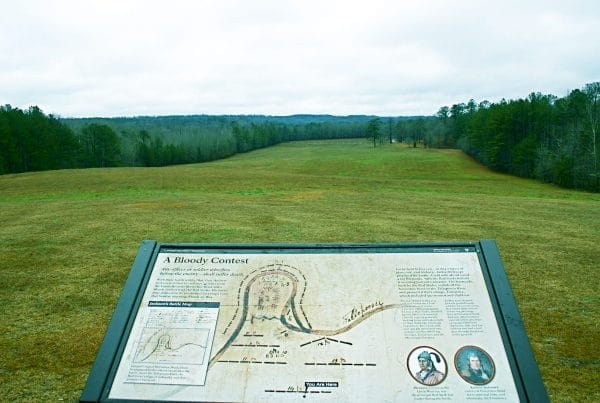 Battlefield at Horseshoe Bend
Many Creeks accepted, if not embraced, the new order of things. Creek leaders such as William McIntosh of the Coweta and Big Warrior of the Tuckabatchee benefited from the new economy and became close allies with Hawkins and other U.S. agents. Many opened taverns and stage stops along the newly constructed Federal Road, which connected Fort Mitchell, in present-day Russell County, with Mobile. Creek traditionalists, in contrast, became increasingly defensive of their sovereignty and culture. Their concerns reached new heights after white settlers began pouring into Alabama Territory on the Federal Road. In 1813, a group of warriors belonging to this traditionalist group, inspired by local “prophets” such as Josiah Francis (Creek name, Hilis Hadjo) and the pan-Indian, nativist movement founded by Shawnee warrior Tecumseh (who himself visited the Creeks in 1811), began fighting back. The Creek War, also known as the Red Stick Revolt after the red war clubs carried by the Creek fighters, was partly a war against the U.S. government and partly an internal war between rival Creek factions led by Francis and Big Warrior. After scoring early victories at places such as Ft. Mims, the Red Stick Creeks, led by Menawa, were ultimately defeated by U.S. forces, led by Gen. Andrew Jackson, and their Creek and Cherokee allies at the Battle of Horseshoe Bend (1814). In the subsequent Treaty of Fort Jackson (1814) and Treaty of Indian Springs (1825), the Creeks ceded all of their remaining lands in Georgia, causing the nation to relocate entirely into Alabama. Only a small faction of Creek leaders, led by William McIntosh, signed the Indian Springs treaty, and many Creeks thus viewed it as fraudulent. Under Creek law, McIntosh’s action was punishable by death, and the Creek National Council shortly thereafter executed McIntosh and three others who had signed the treaty.
Battlefield at Horseshoe Bend
Many Creeks accepted, if not embraced, the new order of things. Creek leaders such as William McIntosh of the Coweta and Big Warrior of the Tuckabatchee benefited from the new economy and became close allies with Hawkins and other U.S. agents. Many opened taverns and stage stops along the newly constructed Federal Road, which connected Fort Mitchell, in present-day Russell County, with Mobile. Creek traditionalists, in contrast, became increasingly defensive of their sovereignty and culture. Their concerns reached new heights after white settlers began pouring into Alabama Territory on the Federal Road. In 1813, a group of warriors belonging to this traditionalist group, inspired by local “prophets” such as Josiah Francis (Creek name, Hilis Hadjo) and the pan-Indian, nativist movement founded by Shawnee warrior Tecumseh (who himself visited the Creeks in 1811), began fighting back. The Creek War, also known as the Red Stick Revolt after the red war clubs carried by the Creek fighters, was partly a war against the U.S. government and partly an internal war between rival Creek factions led by Francis and Big Warrior. After scoring early victories at places such as Ft. Mims, the Red Stick Creeks, led by Menawa, were ultimately defeated by U.S. forces, led by Gen. Andrew Jackson, and their Creek and Cherokee allies at the Battle of Horseshoe Bend (1814). In the subsequent Treaty of Fort Jackson (1814) and Treaty of Indian Springs (1825), the Creeks ceded all of their remaining lands in Georgia, causing the nation to relocate entirely into Alabama. Only a small faction of Creek leaders, led by William McIntosh, signed the Indian Springs treaty, and many Creeks thus viewed it as fraudulent. Under Creek law, McIntosh’s action was punishable by death, and the Creek National Council shortly thereafter executed McIntosh and three others who had signed the treaty.
 Opothle Yoholo
In 1830, the federal government passed the Indian Removal Act, which authorized the eventual removal of all the southeastern tribes to Indian Territory (now Oklahoma). Although a few Creek leaders embraced removal as a means of self-preservation, the vast majority of Creeks opposed abandoning their ancestral homelands. White squatters continued to infiltrate the Creeks’ remaining homelands in Alabama, and the state government asserted its sovereignty in 1831 by extending its laws to unceded Creek territories. Creek leaders sent a delegation, headed by Tuckabatchee leader Opothle Yoholo, to Washington to defend their treaty rights and issue complaints against such actions, which authorities in Washington had done nothing to address. While in Washington, the delegation sensed the futility of their attempts to avert removal and on March 24, 1832, Creek delegates agreed to the Treaty of Cusseta, which set forth the conditions of their removal. On paper, the treaty included several incentives, such as land grants for leading chiefs and the promise of protection from white intruders, which might have encouraged a sizable number of Creeks to stay in Alabama or, at the very least, allow them to make advance preparations for removal. But the defeat of an attempted Creek rebellion in 1836 during the Second Creek War brought immediate forced removal by the U.S. government to the Creek Nation. Opothle Yoholo led several thousand of his followers out west after a failed attempt at purchasing land in Mexico. A year later, 5,000 more Creeks departed. A few who accepted land allotments or evaded removal stayed behind. Some of their descendants have unified as the Poarch Band of Creek Indians, headquartered in Atmore, Alabama.
Opothle Yoholo
In 1830, the federal government passed the Indian Removal Act, which authorized the eventual removal of all the southeastern tribes to Indian Territory (now Oklahoma). Although a few Creek leaders embraced removal as a means of self-preservation, the vast majority of Creeks opposed abandoning their ancestral homelands. White squatters continued to infiltrate the Creeks’ remaining homelands in Alabama, and the state government asserted its sovereignty in 1831 by extending its laws to unceded Creek territories. Creek leaders sent a delegation, headed by Tuckabatchee leader Opothle Yoholo, to Washington to defend their treaty rights and issue complaints against such actions, which authorities in Washington had done nothing to address. While in Washington, the delegation sensed the futility of their attempts to avert removal and on March 24, 1832, Creek delegates agreed to the Treaty of Cusseta, which set forth the conditions of their removal. On paper, the treaty included several incentives, such as land grants for leading chiefs and the promise of protection from white intruders, which might have encouraged a sizable number of Creeks to stay in Alabama or, at the very least, allow them to make advance preparations for removal. But the defeat of an attempted Creek rebellion in 1836 during the Second Creek War brought immediate forced removal by the U.S. government to the Creek Nation. Opothle Yoholo led several thousand of his followers out west after a failed attempt at purchasing land in Mexico. A year later, 5,000 more Creeks departed. A few who accepted land allotments or evaded removal stayed behind. Some of their descendants have unified as the Poarch Band of Creek Indians, headquartered in Atmore, Alabama.
The majority of the Poarch Band’s 2,340 members live in Escambia County, Alabama, on a 230-acre reservation. They are the only federally recognized Indian tribe in Alabama and operate as a sovereign nation with their own system of government and bylaws. Long ignored, impoverished, and subjected to the “separate but equal” provisions of Jim Crow laws, the Poarch Band now operates three gaming facilities in Alabama. In partnership with the state of Alabama, the Poarch Band of Creek Indians contributes to economic and cultural life of its members and the surrounding communities.
Further Reading
- Braund, Kathryn E. Holland. Deerskins and Duffels: The Creek Indian Trade with Anglo-America, 1685–1815. Lincoln: University of Nebraska Press, 1993.
- Bunn, Mike. Fourteenth Colony: The Forgotten Story of the Gulf South During America’s Revolutionary Era. Montgomery: NewSouth Books, 2020.
- Green, Michael D. The Politics of Indian Removal: Creek Government and Society in Crisis. Lincoln: University of Nebraska Press, 1982.
- Hahn, Steven C. The Invention of the Creek Nation, 1670–1763. Lincoln: University of Nebraska Press, 2004.
- Martin, Joel. Sacred Revolt: The Muscogees’ Struggle for a New World. Boston: Beacon Press, 1991.
- Piker, Josh. Okfuskee: A Creek Indian Town in Colonial America. Cambridge, Mass.: Harvard University Press, 2004.
- Saunt, Claudio. A New Order of Things: Property, Power, and the Transformation of the Creek Indians, 1733–1816. New York: Cambridge University Press, 1999.
